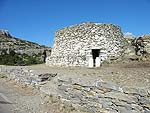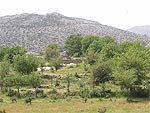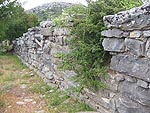| The valley north of the village is Anogia's agricultural
area where vine, vegetables, olives, various fruit trees and a little corn
are cultivated. There are furthermore some pigsties and abandoned
windmills.
|

|
| In the valley are the churches
of Agios Nikitas, Agia Triada and Agios Antonios.
|
| In former times most
of the area was covered with woods, but throughout the years they have
burned or been cut down. Today there are only scattered groups of Holm oak,
maple and ordinary oak.
|
| The lack of wooded areas has
caused a drastic decrease in the number of wild animals,
particularly partridges and hares. The endemic wild goat, the kri-kri,
also lived
here but has
now completely disappeared.
|
| The mountainous hinterland
south of the village is almost entirely used as grazing areas, for example
the Kambi plain and the large Nida plateau (2,2 x 1,6 km). There are
several springs in the mountains, and after World War II 21 big cisterns
were built for accumulation of rainwater, as the area has a yearly fall of
rain and snow of 1-1,3 m. Anogia gets its water from the spring of
Zominthos and other nearby springs, and a large reservoir has been built a
little south of the village in order to collect water reserves for dry
periods. |

|
|
|
|
 |
An interesting sight in the
mountains is the numerous stone huts (mitáto). Until the road to Nida was
made - and before cars became a common possession - the shepherds lived
all summer in these mitatos near their herds of sheep and goats. After
having walked in the mountains all day they returned to the huts in the
evening to have a simple but nutritious meal - generally consisting of mizíthra
(soft cheese), olives, vegetables and slices of dried bread (paximádi). |
|
|
|
|
 |
The shepherds worked together
in groups i.e. one person was responsible for the goats, another for the
sheep, a third for the cheese production and a fourth for the cooking and
other domestic activities. |

|
|
|
|
|

|
Formerly the shepherds
produced the cheese themselves at the huts, but they have now handed over
the production to the co-operative dairy. Every morning when the shepherds
have finished the milking, they therefore drive down from the mountains to
the dairy with the fresh raw-milk.
|

|
|
|
|
|

|
Dairies producing cheese,
existed also in former times as joint property, for example the old
Venetian cheese-dairy near the Zominthos spring.
|

|
|
|
|
|

|
Another
sight at Zominthos are the excavations of a large building dating from Late
Minoan Period. The excavations were directed by the archeologist Giannis
Sakellarakis in the period 1982-2010. After his dead his wife Efi Sapouna
took over the further excavations of the huge complex, estimated to be one
hectare big.
|

|
|
|
|
|
 |
The
central building consisted of more than 40 rooms and covered an area of
1.600 m2, which makes the building to the largest known
country-house from Minoan time. |
|
|
| The
northern walls are still preserved up to the height of 2,5 m, and there
are indications that the building also had a first floor. |

|
|
|
 |
In
one of the rooms there has been excavated a pottery (probably of later
date) with among other things two vessels for the cleaning of the clay.
When they were found, the lower vessel was still filled with clean clay.
Except from the potter's wheel there were also excavated 250 pieces of
pottery, of which at least 12 were decorated. |
|
|
| The
use of the big complex is still unknown, but a theory says that it was
utilized as a hostelry for the pilgrims on their way to the Cave of Zeus
at the Nida tableland. |

|
|
|
|
| A number of small churches have
been built in the mountains: Agia Marina, Agios Mamas, Agios Fanourios and
Christos. It is recommendable to turn aside to the right towards Agios
Yakinthos to admire the very unusual church built like a mitato. Every
year the Yakinthia Festival is started off here. |

|
|
|
|
The
Agia Marina church |
 |
Before you reach the Nida
plateau, a road branches of towards the observatory on Skinakas. The
observatory is closed for most part of the year, but is open to the public
one day every month in the summer season. The road leads through the
extremely stony area of Petradolakia. |
|
|
|
|
| From the Nida plateau a path
leads up to the summit of Psiloritis. It takes 5 hours to reach the top,
where the stone church dedicated to The Holy Cross (Tímios Stavrós) is
situated. From here you can enjoy the formidable view over the entire
island. Many Anogians go up here to participate in the celebration of the
church on July 15th and 16th. |

|
|
|

|
Before the ascent
there is an opportunity to have a refreshment in the tourist centre in
Analipsi.
|
|
| From here you may also
visit the nearby Zeus Cave (Idaío Ándro), where Zeus according to tradition was born and grew up in
hiding from his father's anger. Today the cave is also called the Herd
Girl's Cave (Spiliára tis voskopoúlas).
|
| According to the
mythology of Antiquity, Chronos had been foretold that he was going to
loose his power to his son, as he himself had seized power from his own
father. Therefore he swallowed his children as soon as they had been born.
In order to avoid this, his wife, Rhea, went to Crete when she was going
to give birth to her son Zeus.
|

|
| After the birth Rhea gave to
the unsuspecting Chronos a
stone wrapped in clothes, and he swallowed
it,
convinced that it was the
newborn Zeus.
|
|
| Secretly Zeus grew up
in the cave in Crete, drinking milk from the goat Amathea and eating honey
from the holy bees, while the Curetes performed their noisy weapon-dance
outside the cave to prevent Chronos from hearing the cry of the tiny Zeus.
|
| When he had grown up, Zeus
became the chief leader of the 12 gods of Antiquity as well as
the protector of the state, the family, the strangers and the poor.
|
| Every 9th year king Minos of
Knossos travelled to the cave to ask Zeus for a renewal of his permit to
reign and for the new guidelines and divine laws. |
|
|
|
|








